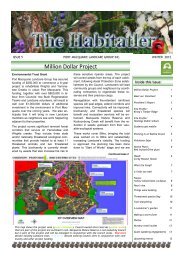Get the Latest information on fighting weeds - Port Macquarie ...
Get the Latest information on fighting weeds - Port Macquarie ...
Get the Latest information on fighting weeds - Port Macquarie ...
You also want an ePaper? Increase the reach of your titles
YUMPU automatically turns print PDFs into web optimized ePapers that Google loves.
Comm<strong>on</strong> name: Climbing Asparagus Latin name: Asparagus plumosus<br />
FAMILY: ASPARAGACEAE<br />
ORIGIN:<br />
Noxious Weed Category: W5 (Envir<strong>on</strong>mental Weed)<br />
Descripti<strong>on</strong><br />
Habit: A perennial vine to 5m arising from an underground corm in <str<strong>on</strong>g>the</str<strong>on</strong>g> same fashi<strong>on</strong> as edible asparagus<br />
A. officinalis. In some instances, however, a creeping rhizome can develop which may send up new stems.<br />
Leaves: Leaves are in fact fine cladodes (reduced stem segments) which encircle <str<strong>on</strong>g>the</str<strong>on</strong>g> branches at nodes<br />
giving <str<strong>on</strong>g>the</str<strong>on</strong>g> plant a ‘ferny’ appearance. The main lateral branches present in horiz<strong>on</strong>tal planes, as do <str<strong>on</strong>g>the</str<strong>on</strong>g><br />
individual clusters of cladodes (this is a key identifier with o<str<strong>on</strong>g>the</str<strong>on</strong>g>r climbing asparagus). The base of each<br />
branchlet is often subtended by a thorn. Flowers: Small, inc<strong>on</strong>spicuous and born singularly in branchlet<br />
axils. Fruit: The fruit is a spherical, single-seeded berry which ripens from green to black.<br />
Ecology: A. plumosus germinates from a single-seeded fruit and is capable of flowering and fruiting after<br />
two to three years. It is shade tolerant and can invade relatively intact (undisturbed) forest systems. Once<br />
established, like o<str<strong>on</strong>g>the</str<strong>on</strong>g>r weedy Asparagus species, it competes aggressively for soil moisture and dense<br />
infestati<strong>on</strong>s can ‘starve’ nearby deeper-rooted vegetati<strong>on</strong> of water and nutrients. The plant does not spread<br />
vegetatively from stems (apart from <str<strong>on</strong>g>the</str<strong>on</strong>g> growing crown or rhizome) and requires gravity or an animal vector<br />
to facilitate this.<br />
Dispersal: Seeds are eaten by birds, can travel in water and are occasi<strong>on</strong>ally spread in c<strong>on</strong>taminated<br />
garden waste.<br />
C<strong>on</strong>trol<br />
HAND: Seedlings quickly develop str<strong>on</strong>g, clumping roots so even small plants may need crowning out.<br />
Plants <strong>on</strong>ly regrow from <str<strong>on</strong>g>the</str<strong>on</strong>g> crown or creeping rhizome so it is not essential to remove <str<strong>on</strong>g>the</str<strong>on</strong>g> entire root mass,<br />
but it is important to follow and remove all rhizomes. Larger plants can still be rogued out but may require<br />
<str<strong>on</strong>g>the</str<strong>on</strong>g> use of a mattock or similar. In all cases, ei<str<strong>on</strong>g>the</str<strong>on</strong>g>r remove <str<strong>on</strong>g>the</str<strong>on</strong>g> crown. CHEMICAL: Dense infestati<strong>on</strong>s of<br />
seedlings or small plants can be foliar sprayed with 1.5g10L -1 metsulfur<strong>on</strong> methyl (eg Brushoff).



